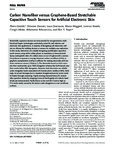Carbon Nanofiber versus Graphene‐Based Stretchable Capacitive Touch Sensors for Artificial Electronic Skin
| dc.contributor.author | Cataldi, Pietro | |
| dc.contributor.author | Dussoni, S | |
| dc.contributor.author | Ceseracciu, L | |
| dc.contributor.author | Maggiali, M | |
| dc.contributor.author | Natale, L | |
| dc.contributor.author | Metta, Giorgio | |
| dc.contributor.author | Athanassiou, A | |
| dc.contributor.author | Bayer, IS | |
| dc.date.accessioned | 2018-12-12T11:47:44Z | |
| dc.date.available | 2018-12-12T11:47:44Z | |
| dc.date.issued | 2018-02 | |
| dc.identifier.issn | 2198-3844 | |
| dc.identifier.issn | 2198-3844 | |
| dc.identifier.other | ARTN 1700587 | |
| dc.identifier.uri | http://hdl.handle.net/10026.1/13018 | |
| dc.description.abstract |
<jats:title>Abstract</jats:title><jats:p>Stretchable capacitive devices are instrumental for new‐generation multifunctional haptic technologies particularly suited for soft robotics and electronic skin applications. A majority of elongating soft electronics still rely on silicone for building devices or sensors by multiple‐step replication. In this study, fabrication of a reliable elongating parallel‐plate capacitive touch sensor, using nitrile rubber gloves as templates, is demonstrated. Spray coating both sides of a rubber piece cut out of a glove with a conductive polymer suspension carrying dispersed carbon nanofibers (CnFs) or graphene nanoplatelets (GnPs) is sufficient for making electrodes with low sheet resistance values (≈10 Ω sq<jats:sup>−1</jats:sup>). The electrodes based on CnFs maintain their conductivity up to 100% elongation whereas the GnPs‐based ones form cracks before 60% elongation. However, both electrodes are reliable under elongation levels associated with human joints motility (≈20%). Strikingly, structural damages due to repeated elongation/recovery cycles could be healed through annealing. Haptic sensing characteristics of a stretchable capacitive device by wrapping it around the fingertip of a robotic hand (ICub) are demonstrated. Tactile forces as low as 0.03 N and as high as 5 N can be easily sensed by the device under elongation or over curvilinear surfaces.</jats:p> | |
| dc.format.extent | 1700587- | |
| dc.format.medium | Electronic-eCollection | |
| dc.language | en | |
| dc.language.iso | eng | |
| dc.publisher | Wiley | |
| dc.subject | artificial electronic skin | |
| dc.subject | carbon nanofibers | |
| dc.subject | elongating tactile sensors | |
| dc.subject | flexible electronics | |
| dc.subject | graphene nanoplatelets | |
| dc.title | Carbon Nanofiber versus Graphene‐Based Stretchable Capacitive Touch Sensors for Artificial Electronic Skin | |
| dc.type | journal-article | |
| dc.type | Journal Article | |
| plymouth.author-url | https://www.webofscience.com/api/gateway?GWVersion=2&SrcApp=PARTNER_APP&SrcAuth=LinksAMR&KeyUT=WOS:000426200000030&DestLinkType=FullRecord&DestApp=ALL_WOS&UsrCustomerID=11bb513d99f797142bcfeffcc58ea008 | |
| plymouth.issue | 2 | |
| plymouth.volume | 5 | |
| plymouth.publication-status | Published | |
| plymouth.journal | Advanced Science | |
| dc.identifier.doi | 10.1002/advs.201700587 | |
| plymouth.organisational-group | /Plymouth | |
| plymouth.organisational-group | /Plymouth/Faculty of Science and Engineering | |
| plymouth.organisational-group | /Plymouth/REF 2021 Researchers by UoA | |
| plymouth.organisational-group | /Plymouth/REF 2021 Researchers by UoA/UoA11 Computer Science and Informatics | |
| dc.publisher.place | Germany | |
| dc.identifier.eissn | 2198-3844 | |
| dc.rights.embargoperiod | Not known | |
| rioxxterms.versionofrecord | 10.1002/advs.201700587 | |
| rioxxterms.licenseref.uri | http://www.rioxx.net/licenses/all-rights-reserved | |
| rioxxterms.type | Journal Article/Review |


